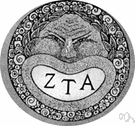tau
Also found in: Thesaurus, Medical, Financial, Acronyms, Encyclopedia, Wikipedia.
tau
(tou, tô)n.
The 19th letter of the Greek alphabet. See Table at alphabet.
[Greek, of Phoenician origin; see tww in Semitic roots.]
American Heritage® Dictionary of the English Language, Fifth Edition. Copyright © 2016 by Houghton Mifflin Harcourt Publishing Company. Published by Houghton Mifflin Harcourt Publishing Company. All rights reserved.
tau
(tɔː; taʊ)n
(Letters of the Alphabet (Foreign)) the 19th letter in the Greek alphabet (Τ, τ), a consonant, transliterated as t
[C13: via Latin from Greek, of Semitic origin; see tav]
Collins English Dictionary – Complete and Unabridged, 12th Edition 2014 © HarperCollins Publishers 1991, 1994, 1998, 2000, 2003, 2006, 2007, 2009, 2011, 2014
tau
(taʊ, tɔ)n., pl. taus.
the 19th letter of the Greek alphabet (T, τ).
[1250–1300; Middle English < Latin < Greek taû < Semitic; compare tav]
Random House Kernerman Webster's College Dictionary, © 2010 K Dictionaries Ltd. Copyright 2005, 1997, 1991 by Random House, Inc. All rights reserved.
ThesaurusAntonymsRelated WordsSynonymsLegend:
Switch to new thesaurus
| Noun | 1. |  tau - the 19th letter of the Greek alphabet tau - the 19th letter of the Greek alphabetGreek alphabet - the alphabet used by ancient Greeks alphabetic character, letter of the alphabet, letter - the conventional characters of the alphabet used to represent speech; "his grandmother taught him his letters" |
Based on WordNet 3.0, Farlex clipart collection. © 2003-2012 Princeton University, Farlex Inc.